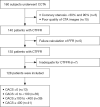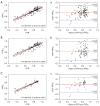Diagnostic performance of coronary computed tomography (CT) angiography derived fractional flow reserve (CTFFR) in patients with coronary artery calcification: insights from multi-center experiments in China
- PMID: 35965817
- PMCID: PMC9372659
- DOI: 10.21037/atm-22-3180
Diagnostic performance of coronary computed tomography (CT) angiography derived fractional flow reserve (CTFFR) in patients with coronary artery calcification: insights from multi-center experiments in China
Abstract
Background: Coronary computed tomography angiography (CCTA) is affected by calcification artifacts, which reduces its diagnostic efficacy. CT-derived fractional flow reserve (CTFFR) based on CCTA has been proven to be accurate in the diagnosis of non-calcified patients, but its clinical use in patients with calcified coronary artery disease remains to be investigated. The purpose of this study was to determine the effect of coronary artery calcification on CTFFR.
Methods: CCTA, coronary angiography, and FFR were performed on 128 patients in three clinical medical centers. Local investigators performed an assessment of stenosis for CCTA and the core laboratory performed the CTFFR calculations. CTFFR ≤0.8 and diameter stenosis ≥50% for CCTA was identified as lesion-specific ischemia. The diagnostic performance of CTFFR in identifying the diagnostic sensitivity, specificity, and accuracy was analyzed using an invasive FFR ≤0.8 as the gold standard. We compared the diagnostic performances between CTFFR and CCTA according to the level of calcification. We divided patients into four groups based on the coronary artery calcification score [coronary artery calcification score (CACS) =0, >0 to <100, ≥100 to <400, and ≥400].
Results: The Youden index indicated an optimal threshold of 0.80 for CTFFR to identify functionally ischemic lesions. The sensitivity, specificity, accuracy, positive predictive value (PPV), negative predictive value (NPV), and area under receiver operating characteristic curve (AUC) for CTFFR on a per-patient basis were 90% (80-96%), 98% (92-99%), 94% (89-97%), 98% (91-99%), 92% (83-97%), and 96.9% (94.2-99.6%), respectively. Compared to CCTA, CTFFR had a higher specificity, accuracy, PPV, NPV, and AUC in both the low to intermediate calcification group and the high calcification group. The diagnostic efficacy of CTFFR was higher than that of CCTA without the influence of calcification.
Conclusions: This Chinese multi-center study showed that CTFFR based on novel computational fluid dynamics (CFD) modeling demonstrated very high diagnostic efficacy compared to the invasive measurement of FFR in all lesions suspected coronary artery disease (CAD). Of particular note are the high specificity, sensitivity, and accuracy of CTFFR, even in patients with calcification, which were significantly better than previous CCTA assessments.
Keywords: CT-derived fractional flow reserve (CTFFR); computed tomography angiography (CTA); coronary artery calcification.
2022 Annals of Translational Medicine. All rights reserved.
Conflict of interest statement
Conflicts of Interest: All authors have completed the ICMJE uniform disclosure form (available at https://atm.amegroups.com/article/view/10.21037/atm-22-3180/coif). YL is from Shenzhen Escope Technology Co., Ltd. The other authors have no conflicts of interest to declare.
Figures



Similar articles
-
Diagnostic accuracy of noninvasive fractional flow reserve derived from computed tomography angiography in ischemia-specific coronary artery stenosis and indeterminate lesions: results from a multicenter study in China.Front Cardiovasc Med. 2023 Oct 2;10:1236405. doi: 10.3389/fcvm.2023.1236405. eCollection 2023. Front Cardiovasc Med. 2023. PMID: 37849942 Free PMC article.
-
Diagnostic accuracy of coronary computed tomography angiography-derived fractional flow reserve.Biomed Eng Online. 2021 Aug 4;20(1):77. doi: 10.1186/s12938-021-00914-3. Biomed Eng Online. 2021. PMID: 34348731 Free PMC article.
-
Noninvasive diagnosis of ischemia-causing coronary stenosis using CT angiography: diagnostic value of transluminal attenuation gradient and fractional flow reserve computed from coronary CT angiography compared to invasively measured fractional flow reserve.JACC Cardiovasc Imaging. 2012 Nov;5(11):1088-96. doi: 10.1016/j.jcmg.2012.09.002. JACC Cardiovasc Imaging. 2012. PMID: 23153908
-
Meta-Analysis of Diagnostic Performance of Coronary Computed Tomography Angiography, Computed Tomography Perfusion, and Computed Tomography-Fractional Flow Reserve in Functional Myocardial Ischemia Assessment Versus Invasive Fractional Flow Reserve.Am J Cardiol. 2015 Nov 1;116(9):1469-78. doi: 10.1016/j.amjcard.2015.07.078. Epub 2015 Aug 14. Am J Cardiol. 2015. PMID: 26347004 Free PMC article. Review.
-
Computed tomography angiography-derived fractional flow reserve (CT-FFR) for the detection of myocardial ischemia with invasive fractional flow reserve as reference: systematic review and meta-analysis.Eur Radiol. 2020 Feb;30(2):712-725. doi: 10.1007/s00330-019-06470-8. Epub 2019 Nov 6. Eur Radiol. 2020. PMID: 31696294
Cited by
-
The Effect of Severe Coronary Calcification on Diagnostic Performance of Computed Tomography-Derived Fractional Flow Reserve Analyses in People with Coronary Artery Disease.Diagnostics (Basel). 2024 Aug 10;14(16):1738. doi: 10.3390/diagnostics14161738. Diagnostics (Basel). 2024. PMID: 39202227 Free PMC article.
-
Diagnostic performance of the quantitative flow ratio and CT-FFR for coronary lesion-specific ischemia.Sci Rep. 2024 Jul 23;14(1):16969. doi: 10.1038/s41598-024-68212-1. Sci Rep. 2024. PMID: 39043839 Free PMC article.
-
Mechanism Analysis of Vascular Calcification Based on Fluid Dynamics.Diagnostics (Basel). 2023 Aug 9;13(16):2632. doi: 10.3390/diagnostics13162632. Diagnostics (Basel). 2023. PMID: 37627891 Free PMC article. Review.
-
A meta-analysis comparing the diagnostic performance of computed tomography-derived fractional flow reserve and coronary computed tomography angiography at different levels of coronary artery calcium score.Eur Radiol. 2024 Sep;34(9):5621-5632. doi: 10.1007/s00330-024-10591-0. Epub 2024 Feb 9. Eur Radiol. 2024. PMID: 38334761
-
The clinical value of noninvasive left ventricular myocardial work in the diagnosis of myocardial ischemia in coronary heart disease: a comparative study with coronary flow reserve fraction.Int J Cardiovasc Imaging. 2024 Oct;40(10):2167-2179. doi: 10.1007/s10554-024-03208-6. Epub 2024 Aug 3. Int J Cardiovasc Imaging. 2024. PMID: 39096407
References
-
- Douglas PS, Pontone G, Hlatky MA, et al. Clinical outcomes of fractional flow reserve by computed tomographic angiography-guided diagnostic strategies vs. usual care in patients with suspected coronary artery disease: the prospective longitudinal trial of FFR(CT): outcome and resource impacts study. Eur Heart J 2015;36:3359-67. 10.1093/eurheartj/ehv444 - DOI - PMC - PubMed
LinkOut - more resources
Full Text Sources
Miscellaneous
